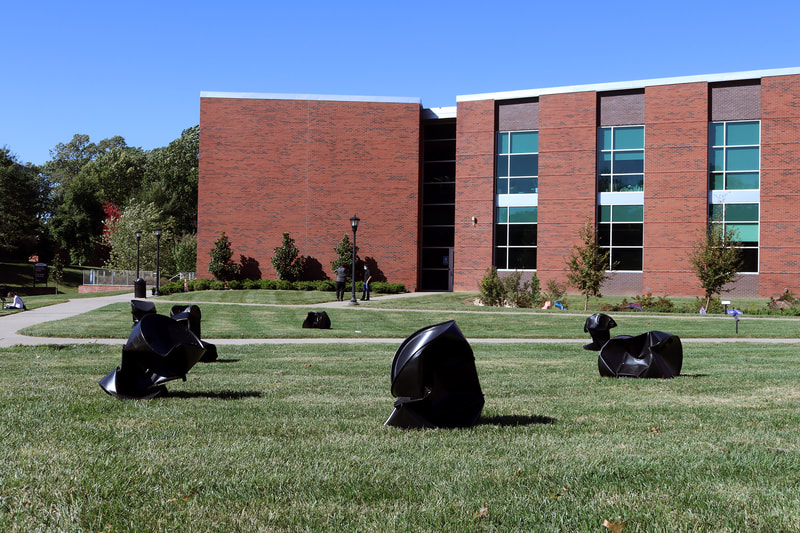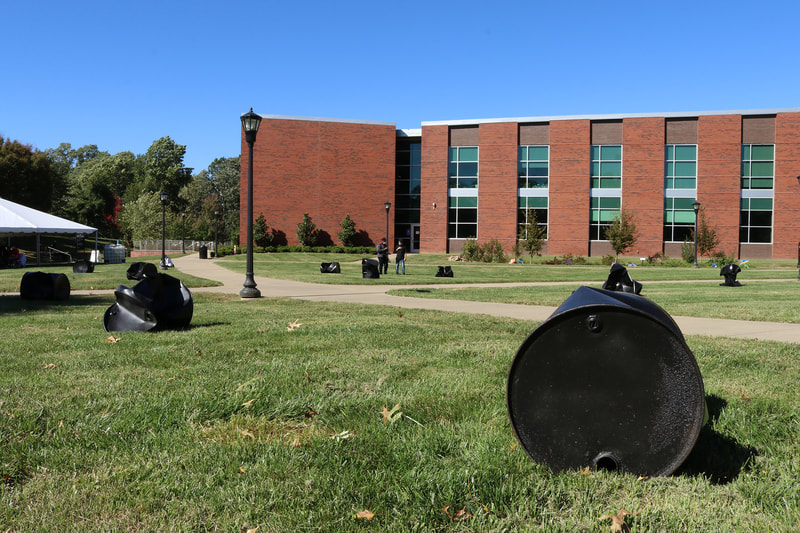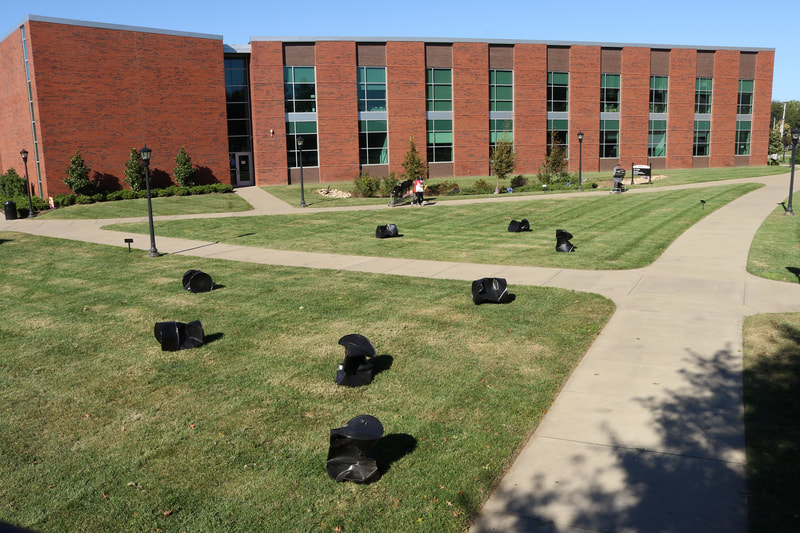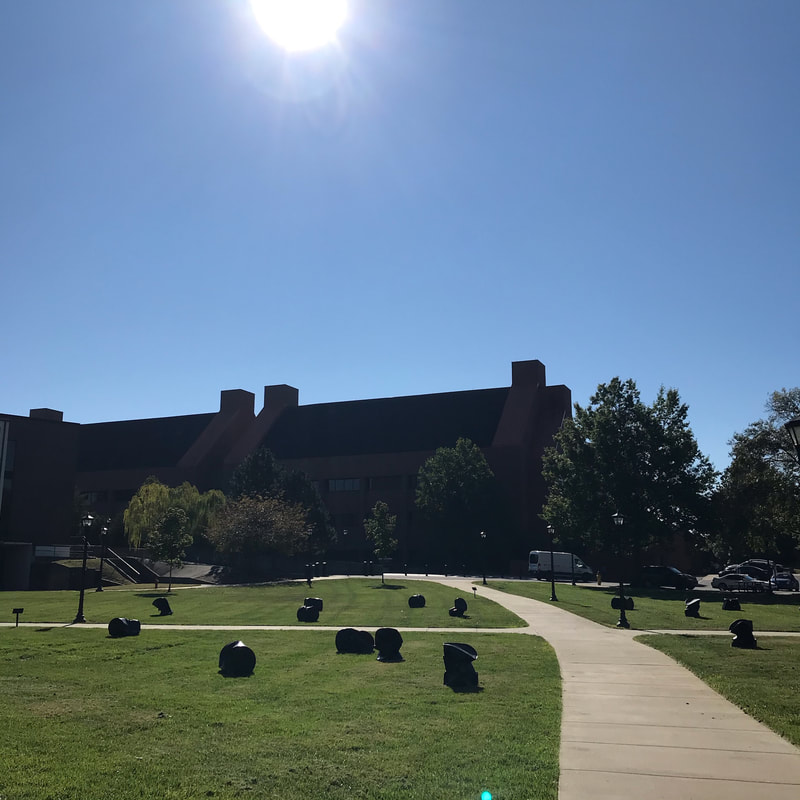Nothing to See Here, 2020
Nothing to See Here is my statement on the continued violence perpetrated against Black bodies and the privilege many of us have to ignore it. As you walk past these barrels, pay attention to the white path that affords you the ability to continue to your destination unobstructed. This installation will periodicaly change with the same bodies placed in new locations revealing the scars underneath.
Thoughts behind the project:
I have a view of this lawn outside of my office window and observe how little the members of the university community step on the grass, but stick to the concrete path. Though the designated pathways may not be the most direct path, they are the most comfortable path to their destination.
These barrels were crushed with an instant violence force created by changes in atmospheric pressure (see here). When approached about using the barrels for a piece, I started seeing the barrels as slumped bodies. The violence that created these bodies became a metaphor for the continued violence against Black bodies, and the color of the path is a metaphor for White privilege, as it's easy to stay on the path of that privilege and ignore the violence around us. The solid blackness of the barrels match that of the lawn light poles, benches and garbage cans, thus becoming part of the planned environment. The barrels are moved once a week to reveal the dead grass underneath - a metaphor for the scars left by the violence - scars that eventually be forgotten by those on the path.
As the viewer enters the piece, the signage is located so that if they read what the piece is about, they then are forced to become aware of the 'bodies', then willfully choose to continue on their path.
Thoughts behind the project:
I have a view of this lawn outside of my office window and observe how little the members of the university community step on the grass, but stick to the concrete path. Though the designated pathways may not be the most direct path, they are the most comfortable path to their destination.
These barrels were crushed with an instant violence force created by changes in atmospheric pressure (see here). When approached about using the barrels for a piece, I started seeing the barrels as slumped bodies. The violence that created these bodies became a metaphor for the continued violence against Black bodies, and the color of the path is a metaphor for White privilege, as it's easy to stay on the path of that privilege and ignore the violence around us. The solid blackness of the barrels match that of the lawn light poles, benches and garbage cans, thus becoming part of the planned environment. The barrels are moved once a week to reveal the dead grass underneath - a metaphor for the scars left by the violence - scars that eventually be forgotten by those on the path.
As the viewer enters the piece, the signage is located so that if they read what the piece is about, they then are forced to become aware of the 'bodies', then willfully choose to continue on their path.
NEWS
Austin Peay artist uses crushed black barrels, white sidewalks to illustrate systemic racial violence
by Brian Dunn, October 6, 2020
Eighteen 55-gallon steel barrels lie among the waves of grass at the Art + Design Quad at Austin Peay State University.
As people pass on white sidewalks through the dark-green field, their images reflect off the barrels’ smooth black paint. The colors are crisp. Whole. The barrels are not. They lie crumpled on their sides.
The barrels, the sidewalks and the grassy field make up APSU Gallery Director Michael Dickins’ latest artwork, “Nothing to See Here.”
“‘Nothing to See Here’ is my statement on the continued violence perpetrated against Black bodies and the privilege many of us have to ignore it,” Dickins says, describing the piece.
For Dickins, the barrels are Black bodies and the sidewalks are the white privilege that passes unobstructed through the violence happening all around.
Dickins has a view of the lawn from his office and can see students as they cross on the sidewalks.
“They’re kind of blind to this gorgeous lawn they’re walking through on this unobstructed white path that makes it so easy to get to their destination without worrying what’s around them,” he says.
Every week, Dickins will move the barrels, revealing dead grass.
“You will see the visible scars of this violence, knowing that the scars will eventually be covered up and forgotten, and we’ll repeat the process that we’re constantly in,” he says.
After four weeks, the 18 barrels will have left 72 scars. All the while, people will stroll through.
Combining art and science“Nothing to See Here” is an extension of one of Dickins’ earlier works, “#thoughtsandprayers,” a 2017 sound collage installation that used a rusty steel barrel.
A speaker inside the barrel broadcast the voices of students and other community members as they read “thoughts and prayers” tweets from politicians after a mass shooting.
The voices echoed out from a barrel often associated with garbage or temporary fires, resulting in a stream of useless tweets from a black hole, Dickins says.
In the years since “#thoughtsandprayers,” APSU’s Bryan Gaither has been routinely crushing steel barrels for his Professional Mad Scientist air pressure demos. You can see one of the demos here to see how well the barrels crumple.
Dr. Karen Meisch, dean of the College of Science, Technology, Engineering and Mathematics, mentioned to Dickins that he use the scrapped barrels in his art.
That idea has grown into art.
A part of something bigger
“Nothing to See Here” is one of the exhibits in the Art + Design Faculty Triennial, an exhibition that showcases the work of Austin Peay faculty. Most of the works are at The New Gallery in the Art + Design building, but some of the works, such as Dickins’, are outside.
The triennial runs through Oct. 23, and anyone interested in seeing the works can stop by between 10 a.m. and 3 p.m. Monday-Thursday.
To maintain social distancing, attendants will enforce a 15-person limit at the gallery. The triennial is free and open to the public.
Austin Peay also is offering a 360-degree virtual walk-through video of the triennial at www.apsu.edu/art-design.
Austin Peay artist uses crushed black barrels, white sidewalks to illustrate systemic racial violence
by Brian Dunn, October 6, 2020
Eighteen 55-gallon steel barrels lie among the waves of grass at the Art + Design Quad at Austin Peay State University.
As people pass on white sidewalks through the dark-green field, their images reflect off the barrels’ smooth black paint. The colors are crisp. Whole. The barrels are not. They lie crumpled on their sides.
The barrels, the sidewalks and the grassy field make up APSU Gallery Director Michael Dickins’ latest artwork, “Nothing to See Here.”
“‘Nothing to See Here’ is my statement on the continued violence perpetrated against Black bodies and the privilege many of us have to ignore it,” Dickins says, describing the piece.
For Dickins, the barrels are Black bodies and the sidewalks are the white privilege that passes unobstructed through the violence happening all around.
Dickins has a view of the lawn from his office and can see students as they cross on the sidewalks.
“They’re kind of blind to this gorgeous lawn they’re walking through on this unobstructed white path that makes it so easy to get to their destination without worrying what’s around them,” he says.
Every week, Dickins will move the barrels, revealing dead grass.
“You will see the visible scars of this violence, knowing that the scars will eventually be covered up and forgotten, and we’ll repeat the process that we’re constantly in,” he says.
After four weeks, the 18 barrels will have left 72 scars. All the while, people will stroll through.
Combining art and science“Nothing to See Here” is an extension of one of Dickins’ earlier works, “#thoughtsandprayers,” a 2017 sound collage installation that used a rusty steel barrel.
A speaker inside the barrel broadcast the voices of students and other community members as they read “thoughts and prayers” tweets from politicians after a mass shooting.
The voices echoed out from a barrel often associated with garbage or temporary fires, resulting in a stream of useless tweets from a black hole, Dickins says.
In the years since “#thoughtsandprayers,” APSU’s Bryan Gaither has been routinely crushing steel barrels for his Professional Mad Scientist air pressure demos. You can see one of the demos here to see how well the barrels crumple.
Dr. Karen Meisch, dean of the College of Science, Technology, Engineering and Mathematics, mentioned to Dickins that he use the scrapped barrels in his art.
That idea has grown into art.
A part of something bigger
“Nothing to See Here” is one of the exhibits in the Art + Design Faculty Triennial, an exhibition that showcases the work of Austin Peay faculty. Most of the works are at The New Gallery in the Art + Design building, but some of the works, such as Dickins’, are outside.
The triennial runs through Oct. 23, and anyone interested in seeing the works can stop by between 10 a.m. and 3 p.m. Monday-Thursday.
To maintain social distancing, attendants will enforce a 15-person limit at the gallery. The triennial is free and open to the public.
Austin Peay also is offering a 360-degree virtual walk-through video of the triennial at www.apsu.edu/art-design.
















